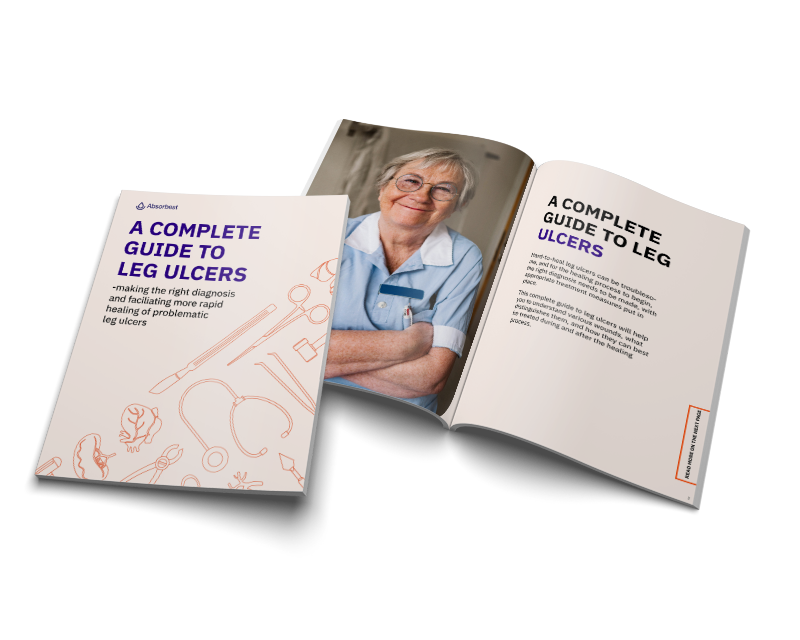The term “retention” may sound technical, but it’s crucial to grasp its significance from the perspective of wound dressings and wound- and exudate management. Understanding its function will provide relevance and knowledge into its role in wound healing.
Superabsorbent dressings play a pivotal role in managing heavily exuding wounds during the initial stages of the wound-healing process. They are specifically designed to handle the excess fluid typically caused by oedema or inflammation. Their primary goal is to maintain an optimal moisture level in the wound and surrounding skin, preventing it from drying or becoming too wet.
Retention is a crucial feature of superabsorbent dressings’ ability to absorb and encapsulate wound exudate inside their core. This goes beyond the absorption capacities and volume of fluid absorbed and involves retaining the exudate within the dressing. It’s a sequence based on two stages that emerge from the dressing’s capacities: first, the dressing absorbs the fluid and then retains it.
When the wound fluid comes into contact with the superabsorbent polymers (SAPs) inside the dressing core, it binds to the polymer chains, forming a complex structure that visibly swells and gels. The dressing’s superabsorbent polymers keep the fluid within their structure, ensuring the exudate is retained even under pressure, for example, when using compression therapy.
Compared to simpler absorbent dressings, which hold fluid in the dressing until pressure is applied (like a dishcloth), the retention feature in superabsorbent dressings is crucial. It helps maintain a humid (warm and moist) wound environment conducive to healing while also preventing the leakage of fluids that can cause maceration of the peri-wound skin. This reduces the risk of transferring bacteriaMihutescu et al, A comparison of bacterial sequestration in SAP dressings, Poster at Wounds UK 2022. and the need for frequent dressing changes and provides a sense of confidence to healthcare professionals.
It’s important to remember that dressings alone do not heal wounds, even though they provide conditions for treatment in a controlled wet environment that favours healingJohan P.E. Junker, Rami A. Kamel, E.J. Caterson, and Elof Eriksson. Clinical Impact Upon Wound Healing and Inflammation in Moist, Wet, and Dry Environments. Adv Wound Care. 2013 Sep: 348–356.. The aetiology of the exudates is conclusive and significantly influences wound management. For instance, if a wound is a consequence of oedema or infection, addressing the underlying cause is essential.
Wound exudate is a natural and vital part of a wound’s healing process. It keeps the wound warm and moist and contains nutrients, proteins, and growth factors that help it heal and form new tissue. However, too much exudate can cause problems. Excess exudate in hard-to-heal wounds contains higher levels of inflammatory molecules, which can prolong the inflammation phase and produce more exudateExpert working group; Satellite expert working group. Wound exudate and the role of dressings. A consensus document. International Wound Journal,
March, 2008.. Concerning the dressing, the absorption and retention properties in a superabsorbent dressing reduce the risk of transferring exudate-containing bacteria back to the wound bedMihutescu et al, A comparison of bacterial sequestration within three types of wound dressing, Poster at Wounds UK 2022..
An optimal moisture balance is critical in moist wound healing and makes wounds heal faster. While exudate production is essential to moist wound healing, it’s often seen as problematic because it can be challenging for clinicians to manage. A key point here is the assessment and classification of the wound-healing stage, which then influences the dressing selectionJackie Stephen-Haynes, Managing exudate and the key requirements of absorbent dressings, British Journal of Community Nursing Vol. 16..
![]()
Successful wound management requires a flexible approach to product selection and use based on understanding the healing process and the properties of the various dressings available. These are examples of the requirements for an ideal dressing for managing exuding woundsJackie Stephen-Haynes, Managing exudate and the key requirements of absorbent dressings, British Journal of Community Nursing Vol. 16..

Excess and uncontrolled wound exudate can inhibit wound healing, affecting clinicians’ ability to carry out their mission. This has significant consequences for the patient, negatively affecting the patient’s health-related quality of life and having avoidable cost implications for the healthcare systemMark Collier, A clinical observational case series evaluation of a superabsorbent dressing on exudating wounds, British Journal of Nursing, 2024, Vol 33..
Given the interplay between the body, the wound, and the dressing, these elements must interact when managing exuding, hard-to-heal wounds, where superabsorbent dressings can be a mainstay of simplicity.

Experience the difference and compare the outcome with our superabsorbent dressing. Designed to create a simple wound healing process and optimal healing environments to support clinicians giving quality care.

This complete guide to leg ulcers will help you to understand various wounds, what distinguishes these, and how they can best be treated during and after the healing process.
Mihutescu et al, A comparison of bacterial sequestration in SAP dressings, Poster at Wounds UK 2022.
Johan P.E. Junker, Rami A. Kamel, E.J. Caterson, and Elof Eriksson. Clinical Impact Upon Wound Healing and Inflammation in Moist, Wet, and Dry Environments. Adv Wound Care. 2013 Sep: 348–356.
Expert working group; Satellite expert working group. Wound exudate and the role of dressings. A consensus document. International Wound Journal,
March, 2008.
Jackie Stephen-Haynes, Managing exudate and the key requirements of absorbent dressings, British Journal of Community Nursing Vol. 16.
Mark Collier, A clinical observational case series evaluation of a superabsorbent dressing on exudating wounds, British Journal of Nursing, 2024, Vol 33.